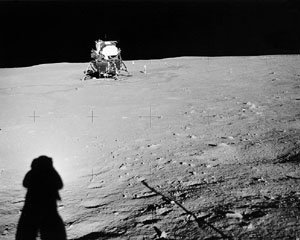|
Size: 3078
Comment:
|
Size: 3078
Comment:
|
| Deletions are marked like this. | Additions are marked like this. |
| Line 14: | Line 14: |
| ||<->'''Apollo 11 heiligenshein'''|| Sun angular size || 0.53° || from moon || | ||<:>'''Apollo 11 heiligenshein'''|| Sun angular size || 0.53° || from moon || |
Lunar Brightness at Opposition
When the moon is directly opposite the sun from the earth, it is in eclipse. The angular size of the sun is 0.53° and the angular size of the Earth from the moon is 1.9°. If the moon is within 0.95-0.53 = ±0.42° it is in the dark umbral shadow, and if it is between that and 0.95+0.53 = ±1.48° it is in partial penumbral shadow. If we were in a spaceship directly between the sun and the moon, without the earth in the way, the moon would appear very bright. This is due to heiligenshein (also known as "opposition effect"), shown below in this Apollo 11 photograph (just past Buzz Aldrin's head), alongside data for the angular geometry of the Moon, Earth, and Sun:
|
Moon semimajor axis |
384,399 km |
|
|
Moon Eccentricity |
0.0549 |
|
|
Moon Perigee |
362,570 km |
394393 ?? |
|
Moon Apogee |
405,410 km |
406728 ?? |
|
Earth mean radius |
6371 km |
|
|
Earth half-angle size |
0.95° |
from moon |
|
Sun mean distance |
1.496e8 km |
|
|
Sun mean diameter |
1.392e6 km |
|
Apollo 11 heiligenshein |
Sun angular size |
0.53° |
from moon |
According to Whitaker, the heilingenshein is 50% greater at 1 degree than at 5%. The reason for this specular reflection is that meteoroid impacts throw up melted debris, which forms into tiny glass beads that cool and harden before they fall back down. These beads act like retroreflectors, much like the glass spheres in Scotchlite. At two degrees off exact opposition (syzygy ) which occurs near lunar eclipse times, the moon is 35% brighter than we would expect from direct reflection.
This occurs when either the moon's ascending or descending node points away from the sun, every 7.8 lunar months or so (slightly longer than half a year because of the 18.6 year nodal precession). The perigee also precesses, making a circuit every 8.9 years, bringing the moon closer by 5% and increasing total lunar reflection light by 11% due to a larger angular size. When these add together, every few years, the full moon is at its brightest, perhaps 50% brighter than average.
NASA SP-201 : Analysis of Apollo 8 photography and visual observations. January 1, 1969. Page 38: Photometry, An Investigation of Lunar Heiligenshein by E. A. Whitaker
. Krisciunas & Schaefer, "A Model of the Brightness of Moonlight", Publications of the Astronautical Society of the Pacific, 103: 1033-1039, September 1991.
notes:
\alpha \equiv phase angle between earth and sun as seen from the moon
Z zenith distance (angle???)

